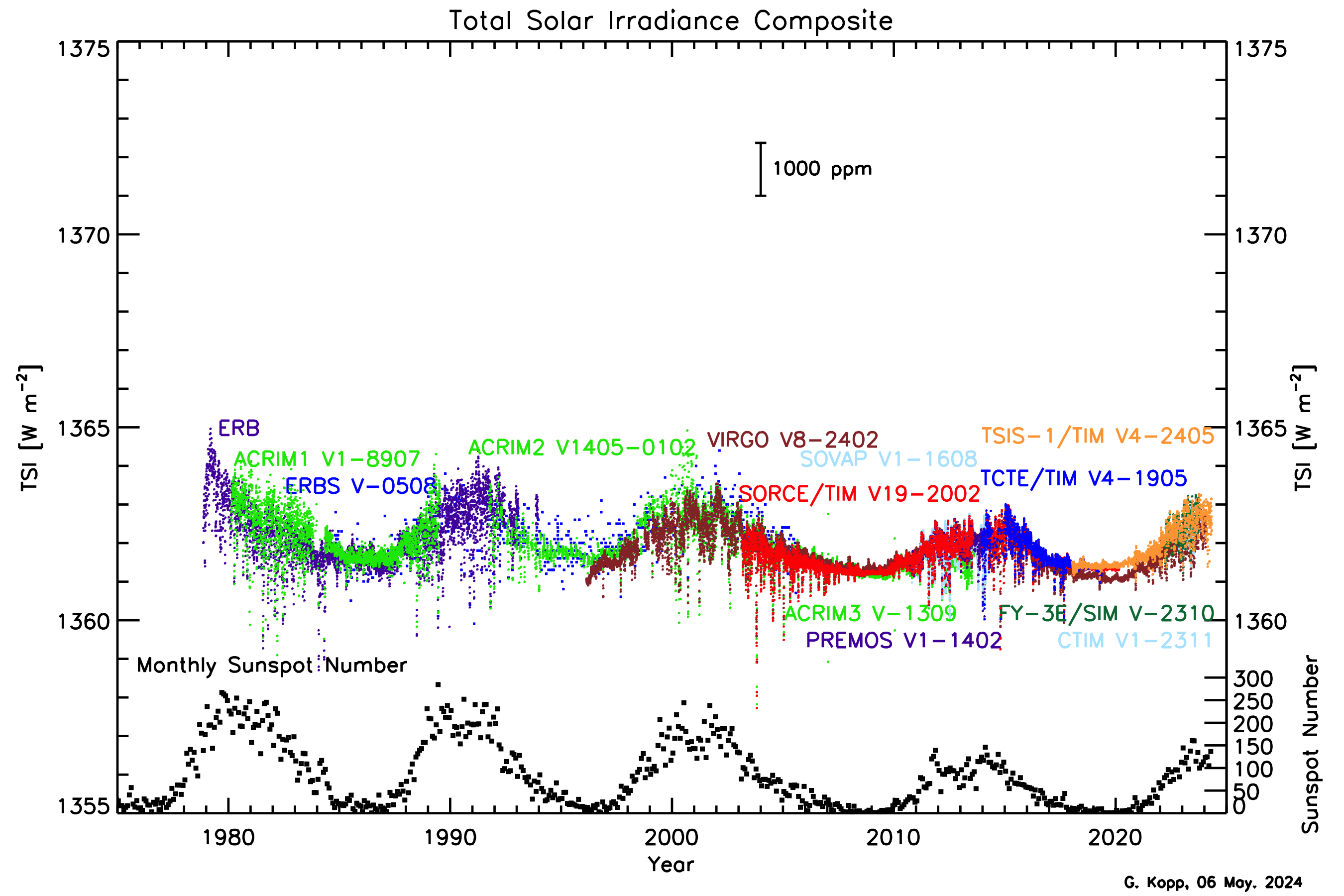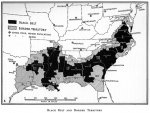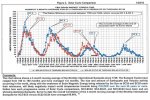von Koehler
Has No Life - Lives on TB
https://phys.org/news/2016-08-solar-impact-earth-cloud.html
Solar activity has a direct impact on Earth's cloud cover
August 25, 2016 by Morten Garly Andersen, Technical University of Denmark
Solar activity has a direct impact on Earth's cloud cover

Credit: Technical University of Denmark
A team of scientists from the National Space Institute at the Technical University of Denmark (DTU Space) and the Racah Institute of Physics at the Hebrew University of Jerusalem has linked large solar eruptions to changes in Earth's cloud cover in a study based on over 25 years of satellite observations.
The solar eruptions are known to shield Earth's atmosphere from cosmic rays.
However the new study, published in Journal of Geophysical Research: Space Physics, shows that the global cloud cover is simultaneously reduced, supporting the idea that cosmic rays are important for cloud formation. The eruptions cause a reduction in cloud fraction of about 2 percent corresponding to roughly a billion tonnes of liquid water disappearing from the atmosphere.
Since clouds are known to affect global temperatures on longer timescales, the present investigation represents an important step in the understanding of clouds and climate variability.
"Earth is under constant bombardment by particles from space called galactic cosmic rays. Violent eruptions at the Sun's surface can blow these cosmic rays away from Earth for about a week. Our study has shown that when the cosmic rays are reduced in this way there is a corresponding reduction in Earth's cloud cover. Since clouds are an important factor in controlling the temperature on Earth our results may have implications for climate change", explains lead author on the study Jacob Svensmark of DTU.
Very energetic particles
These particles generate electrically charged molecules—ions—in Earth's atmosphere. Ions have been shown in the laboratory to enhance the formation of aerosols, which can serve as seeds for the formation of the cloud drops that make up a cloud. Whether this actually happens in the atmosphere, or only in the laboratory is a topic that has been investigated and debated for years.
When the large solar eruptions blow away the galactic cosmic rays before they reach Earth they cause a reduction in atmospheric ions of up to about 20 to -30 percent over the course of a week. So if ions affect cloud formation it should be possible to observe a decrease in cloud cover during events when the Sun blows away cosmic rays, and this is precisely what is done in this study.

Solar activity has a direct impact on Earth's cloud cover
Credit: Technical University of Denmark
The so-called 'Forbush decreases' of the cosmic rays have previously been linked to week-long changes in Earth's cloud cover but the effect has been debated at length in the scientific literature. The new study concludes that "there is a real impact of Forbush decreases on cloud microphysics" and that the results support the suggestion that "ions play a significant role in the life-cycle of clouds".
Arriving at that conclusion was, however, a hard endeavor; Very few strong Forbush decreases occur and their effect on cloud formation is expected to be close to the limit of detection using global atmospheric observations measured by satellites and land based stations. Therefore it was of the greatest importance to select the strongest events for study since they had to have the most easily detected effect. Determining this strength required combining data from about 130 stations in combination with atmospheric modeling.
This new method resulted in a list of 26 events in the period of 1987-2007 ranked according to ionization. This ranked list was important for the detection of a signal, and may also shed some light on why previous studies have arrived at varied conclusions, since they have relied on events that were not necessarily ranked high on the list.
Possible long term effect
The effect from Forbush decreases on clouds is too brief to have any impact on long-term temperature changes.
However since clouds are affected by short term changes in galactic cosmic radiation, they may well also be affected by the slower change in Solar activity that happens on scales from tens to hundreds of years, and thus play a role in the radiation budget that determines the global temperature.
The Suns contribution to past and future climate change may thus be larger than merely the direct changes in radiation, concludes the scientists behind the new study.
More information: J. Svensmark et al, The response of clouds and aerosols to cosmic ray decreases, Journal of Geophysical Research: Space Physics (2016). DOI: 10.1002/2016JA022689
Provided by: Technical University of Denmark
Read more at: https://phys.org/news/2016-08-solar-impact-earth-cloud.html#jCp
Solar activity has a direct impact on Earth's cloud cover
August 25, 2016 by Morten Garly Andersen, Technical University of Denmark
Solar activity has a direct impact on Earth's cloud cover

Credit: Technical University of Denmark
A team of scientists from the National Space Institute at the Technical University of Denmark (DTU Space) and the Racah Institute of Physics at the Hebrew University of Jerusalem has linked large solar eruptions to changes in Earth's cloud cover in a study based on over 25 years of satellite observations.
The solar eruptions are known to shield Earth's atmosphere from cosmic rays.
However the new study, published in Journal of Geophysical Research: Space Physics, shows that the global cloud cover is simultaneously reduced, supporting the idea that cosmic rays are important for cloud formation. The eruptions cause a reduction in cloud fraction of about 2 percent corresponding to roughly a billion tonnes of liquid water disappearing from the atmosphere.
Since clouds are known to affect global temperatures on longer timescales, the present investigation represents an important step in the understanding of clouds and climate variability.
"Earth is under constant bombardment by particles from space called galactic cosmic rays. Violent eruptions at the Sun's surface can blow these cosmic rays away from Earth for about a week. Our study has shown that when the cosmic rays are reduced in this way there is a corresponding reduction in Earth's cloud cover. Since clouds are an important factor in controlling the temperature on Earth our results may have implications for climate change", explains lead author on the study Jacob Svensmark of DTU.
Very energetic particles
These particles generate electrically charged molecules—ions—in Earth's atmosphere. Ions have been shown in the laboratory to enhance the formation of aerosols, which can serve as seeds for the formation of the cloud drops that make up a cloud. Whether this actually happens in the atmosphere, or only in the laboratory is a topic that has been investigated and debated for years.
When the large solar eruptions blow away the galactic cosmic rays before they reach Earth they cause a reduction in atmospheric ions of up to about 20 to -30 percent over the course of a week. So if ions affect cloud formation it should be possible to observe a decrease in cloud cover during events when the Sun blows away cosmic rays, and this is precisely what is done in this study.

Solar activity has a direct impact on Earth's cloud cover
Credit: Technical University of Denmark
The so-called 'Forbush decreases' of the cosmic rays have previously been linked to week-long changes in Earth's cloud cover but the effect has been debated at length in the scientific literature. The new study concludes that "there is a real impact of Forbush decreases on cloud microphysics" and that the results support the suggestion that "ions play a significant role in the life-cycle of clouds".
Arriving at that conclusion was, however, a hard endeavor; Very few strong Forbush decreases occur and their effect on cloud formation is expected to be close to the limit of detection using global atmospheric observations measured by satellites and land based stations. Therefore it was of the greatest importance to select the strongest events for study since they had to have the most easily detected effect. Determining this strength required combining data from about 130 stations in combination with atmospheric modeling.
This new method resulted in a list of 26 events in the period of 1987-2007 ranked according to ionization. This ranked list was important for the detection of a signal, and may also shed some light on why previous studies have arrived at varied conclusions, since they have relied on events that were not necessarily ranked high on the list.
Possible long term effect
The effect from Forbush decreases on clouds is too brief to have any impact on long-term temperature changes.
However since clouds are affected by short term changes in galactic cosmic radiation, they may well also be affected by the slower change in Solar activity that happens on scales from tens to hundreds of years, and thus play a role in the radiation budget that determines the global temperature.
The Suns contribution to past and future climate change may thus be larger than merely the direct changes in radiation, concludes the scientists behind the new study.
More information: J. Svensmark et al, The response of clouds and aerosols to cosmic ray decreases, Journal of Geophysical Research: Space Physics (2016). DOI: 10.1002/2016JA022689
Provided by: Technical University of Denmark
Read more at: https://phys.org/news/2016-08-solar-impact-earth-cloud.html#jCp













